
Calotes is a genus of lizards in the draconine clade of the family Agamidae. The genus contains 25 species. Some species are known as forest lizards, others as "bloodsuckers" due to their red heads, and yet others as garden lizards.

Pseudocalotes is a genus of agamid lizards endemic to Southeast Asia.
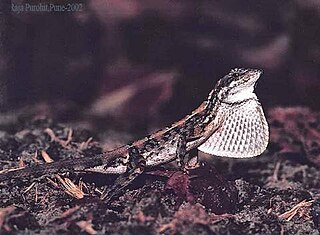
Sitana is a genus of lizards, collectively known as the fan-throated lizards, from the family Agamidae. They are found in Nepal, India, Sri Lanka and Pakistan. The genus comprises thirteen species, including several recently discovered species, such as two new species from Sri Lanka. In 2016, a new genus named Sarada was erected, consisting of one former Sitana species and two newly described ones. Sarada is the sister genus of Sitana. Together they form a clade which sister group is Otocryptis.
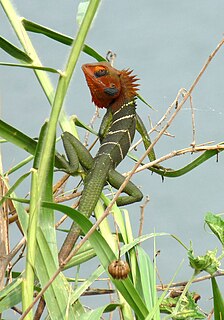
Calotes calotes is an agamid lizard found in the forests of the Western Ghats and the Shevaroy Hills in India, and Sri Lanka.

Monilesaurus ellioti, or Elliot's forest lizard, is a species of arboreal, diurnal, lizard in the family Agamidae, endemic to the Western Ghats, India.

Calotes grandisquamis, the large-scaled forest lizard, is an arboreal, diurnal, insectivorous agamid lizard found in the evergreen rainforests of the Western Ghats of India; distributed from Agumbe to Agasthyamalai Hills.

Calotes jerdoni, commonly known as the Indo-Chinese forest lizard or Jerdon's forest lizard, is a species of lizard in the family Agamidae. The species is endemic to China and South Asia.
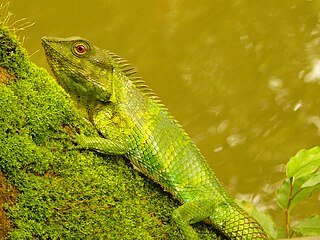
Calotes nemoricola, the Nilgiri forest lizard, is an agamid lizard found in the Western Ghats of India.
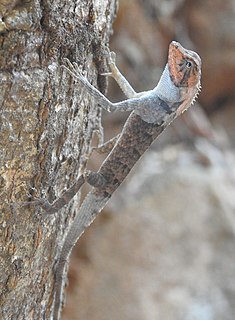
Monilesaurus rouxii, commonly known as Roux's forest lizard, Roux's forest calotes, or the forest blood sucker, is a species of arboreal, diurnal, agamid lizard, which is endemic to hills of peninsular India. In July 2018, it was proposed that the species should be transferred to the new genus Monilesaurus.

Cyrtodactylus collegalensis, also known as the Kollegal ground gecko or forest spotted gecko, is a species of gecko found in and around Mysore hills, at the junction of the Western Ghats and the Eastern Ghats, in South India. Recent taxonomic works and genetic studies revealed that the formerly-supposed genus is actually a subgenus of the widespread genus Cyrtodactylus. It is often confused with the forest spotted gecko.

Ahaetulla, commonly referred to as Asian vine snakes or Asian whip snakes, is a genus of colubrid snakes distributed throughout tropical Asia. They are considered by some scientists to be mildly venomous and are what is commonly termed as 'rear-fanged' or more appropriately, opisthoglyphous, meaning their enlarged teeth or fangs, intended to aid in venom delivery, are located in the back of the upper jaw, instead of in the front as they are in vipers or cobras. As colubrids, Ahaetulla do not possess a true venom gland or a sophisticated venom delivery system. The Duvernoy's gland of this genus, homologous to the venom gland of true venomous snakes, produces a secretion which, though not well studied, is considered not to be medically significant to humans.
Microauris is a monotypic genus of agamid lizard. Its only species is Microauris aurantolabium, also known as the small-eared dragon or orange-lipped forest lizard, found in the forests of the southern Western Ghats and is currently known from the Kalakkad Mundanthurai Tiger Reserve. The species was formerly included in Pseudocalotes andamanensis of the Andaman Islands, but recognized as distinct in 2008. It was also classified under Calotes until 2018, where it was transferred to its own genus, Microauris, on the basis of its divergence from Calotes.

The Draconinae are a subfamily of reptiles in the family Agamidae found in southern Asia and Oceania. Some taxonomists believe these genera belong to the subfamily Agaminae.

Pseudocalotes andamanensis is an agamid lizard found on the Nicobar Islands and the Andaman Islands in India. It is also known as the green crestless forest lizard, Andaman and Nicobar forest lizard, Andaman lizard, or Andaman green calotes. This species is an almost exclusive canopy dweller, and is rarely seen.

The whistling lizard, or Sri Lanka agama, Calotes liolepis is a species of lizard in the family Agamidae. It is one of four Calotes species endemic to Sri Lanka.
Calotes desilvai, commonly known as the Morningside lizard, or the Ceylon black-band whistling lizard, is a species of lizard in the family Agamidae. Calotes desilvai is one of seven Calotes species endemic to Sri Lanka.
The Pethiyagoda's crestless lizard is an agamid lizard endemic to Sri Lanka. Locally known as පෙතියාගොඩගේ නොසිලු කටුස්සා.

Walkerana muduga, also known as the Muduga mountain leaping frog or Muduga leaping frog, is a species of frog in the family Ranixalidae. It is endemic to the Western Ghats of India and known from the Elivai Malai range, north of the Palghat Gap in Tamil Nadu. All other known species of Walkerana occur south of the Palghat Gap, and molecular data suggest that Walkerana muduga is deeply divergent from the more southern species. However, there is another, as yet undescribed lineage from north of the Palghat Gap that is known from a single, poorly preserve specimen.
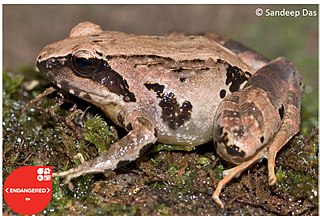
Walkerana is a genus of frogs in the family Ranixalidae. The genus is endemic to the Western Ghats in the states of Kerala and Tamil Nadu, India. It was erected in 2016 to host three species of Indirana that represented a genetically and morphologically distinct clade within the then broadly defined Indirana. Until Walkerana muduga was described in 2020, the genus was only known from the southernmost part of the Western Ghats south of the Palghat Gap.
















